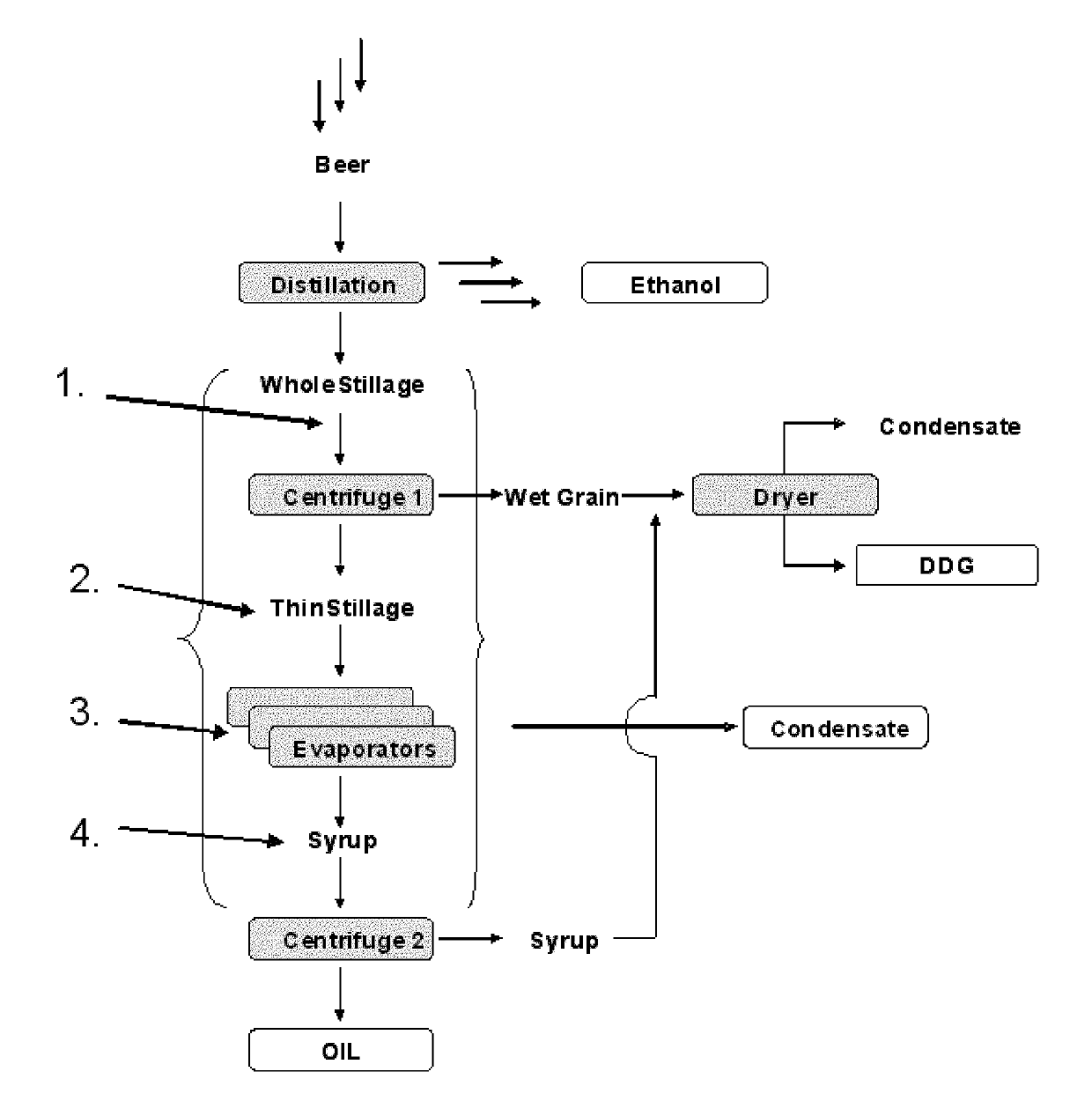Oil extraction aids in bioproduct production
a bioproduct and oil extraction technology, applied in the direction of fatty oil/acid recovery from waste, fatty oil/fat refining, separation processes, etc., can solve the problems of many commercial installations falling far short, and still some oil that is not recovered from the syrup
- Summary
- Abstract
- Description
- Claims
- Application Information
AI Technical Summary
Benefits of technology
Problems solved by technology
Method used
Image
Examples
example 1
[0104]The effect of the use of Polysorbate 80 with PEG-36 Castor Oil on process additive system efficacy was examined. Process additive systems were tested by addition of a predetermined dose to 80 mL of corn syrup at 90° C. then briefly mixed. 65 mL of each sample was transferred to a centrifuge tube and was then centrifuged for 10 minutes at 2000 rpm. The amount of oil was determined by measuring the height of the oil layer in the centrifuge tube.
[0105]
TABLE 1Composition (wt %)PolysorbatePEG-36Oil Released (mm) at Dose of80Castor Oil100 ppm250 ppm500 ppm100% 4.812.018.075%25%7.619.426.550%50%10.021.224.025%75%8.616.221.0100% 5.015.819.0
[0106]As can be seen in Table 1, the use of Polysorbate 80 with PEG-36 Castor Oil resulted in significantly increased oil release when compared to Polysorbate 80 or PEG-36 Castor Oil alone. This is unexpected since the expectation would be that the performance of the mixtures containing both Polysorbate 80 and PEG-36 Castor Oil would not be greater ...
example 2
[0107]The effect of the use of Polysorbate 80 with PEG-36 Castor Oil on process additive system efficacy was examined. Process additive systems also contained hydrophobic silica with or without soybean fatty acid methyl ester. Process additive systems were tested by addition of a 200 ppm dose to 80 mL of corn syrup at 90° C. then briefly mixed. 65 mL of each sample was transferred to a centrifuge tube and was then centrifuged for 30 minutes at 2000 rpm. The amount of oil was determined by measuring the height of the oil layer in the centrifuge tube.
[0108]
TABLE 2Composition (wt %)SoybeanFatty AcidOilPolysorbatePEG-36MethylHydrophobicReleased80Castor OilEsterSilica(mm)90%10%19.036%54%10%20.372%18%10%18.763%27%10%19.718%54%18%10%22.027%27%36%10%20.545%27%18%10%20.590%10%18.554%36%10%17.554%36%10%15.0
[0109]As can be seen in Table 2, the process additive systems containing both Polysorbate 80 and PEG-36 Castor Oil resulted in significantly increased oil release when compared to those con...
example 3
[0110]Polysorbate 80 (Additive 1) and a blend of 50 wt % Polysorbate 80 with 40 wt % PEG-36 Castor Oil and 10 wt % soybean fatty acid methyl esters (Additive 2) were added into the syrup feed line on the inlet side of the pump feeding a disk stack centrifuge in a corn to ethanol process. The resulting corn oil production is shown in Table 3. Change in process additive dosage and change in oil production are compared to baseline data obtained from Polysorbate 80 in its initial test. All tests were conducted sequentially and the order of testing is shown in Table 3. Additive 1 was tested at the beginning and end of the run to confirm oil production returned to baseline levels.
[0111]
TABLE 3AdditiveAdditiveAdditiveAdditiveAdditive12221Order of Testing12345Dose (ppm)920800660920920Change in Dose−13%−28%0% 0%Oil Production3.423.503.713.633.41(gal / min)Change in Oil 2% 8%6%−1%Production
[0112]As shown in Table 3, the process additive systems containing both Polysorbate 80 and PEG-36 Castor O...
PUM
| Property | Measurement | Unit |
|---|---|---|
| temperature | aaaaa | aaaaa |
| temperature | aaaaa | aaaaa |
| temperature | aaaaa | aaaaa |
Abstract
Description
Claims
Application Information
 Login to View More
Login to View More - R&D
- Intellectual Property
- Life Sciences
- Materials
- Tech Scout
- Unparalleled Data Quality
- Higher Quality Content
- 60% Fewer Hallucinations
Browse by: Latest US Patents, China's latest patents, Technical Efficacy Thesaurus, Application Domain, Technology Topic, Popular Technical Reports.
© 2025 PatSnap. All rights reserved.Legal|Privacy policy|Modern Slavery Act Transparency Statement|Sitemap|About US| Contact US: help@patsnap.com

